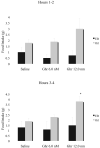Estradiol and the control of food intake
- PMID: 19555704
- PMCID: PMC2813989
- DOI: 10.1016/j.physbeh.2009.06.010
Estradiol and the control of food intake
Abstract
Gonadal steroids are among the many factors that influence food intake and body weight in mammals. Hormonal effects on these processes are particularly striking in female rats, which show large increases in food intake and body weight after ovariectomy. A key role of estradiol in the control of food intake and energy balance in humans is evidenced by the fact that the incidence of obesity increases greatly after menopause [American College of Obstetricians and Gynecologists. Body mass index and insulin resistance. Obstet Gynecol 2004;104:5s-10]. The actions of estradiol on neural systems that regulate eating may also account in part for sex differences in food intake and eating disorders, which occur much more frequently in young women [Sodersten P, Bergh C. Anorexia nervosa: towards a neurobiologically based therapy. Eur J Pharmacol 2003;480:67-74]. This paper presents a minireview of research examining the changes in feeding that occur during the ovarian cycle, the effects of estradiol withdrawal and replacement on food intake and body weight, and the neurobiological mechanisms by which estradiol influences feeding behavior. A model of hormone action on food intake that emerges from this research views estradiol as an indirect control of eating and meal size, producing changes in feeding behavior by modulating the central processing of both satiating and orexigenic peptides that represent direct controls of eating. Some of the shortcomings of the model and directions for future research are discussed.
2009 Elsevier Inc. All rights reserved.
Figures
References
-
- American College of Obstetricians and Gynecologists Body mass index and insulin resistance. Obstet Gynecol. 2004;104:5s–10. - PubMed
-
- Asarian L, Geary N. Cyclic estradiol treatment normalizes body weight and restores physiological patterns of spontaneous feeding and sexual receptivity in ovariectomized rats. Horm Behav. 2002;42:1–12. - PubMed
-
- Asarian L, Geary N. Cyclic estradiol treatment phasically potentiates endogenous cholecystokinin's satiating action in ovariectomized rats. Peptides. 1999;20:445–50. - PubMed
-
- Bagnasco M, Tulipano G, Melis MR, Argiolas A, Cocchi D, Muller EE. Endogenous ghrelin is an orexigenic peptide acting in the arcuate nucleus in response to fasting. Regul Pept. 2003;111:161–67. - PubMed
-
- Beatty WW, O'Briant DA, Vilberg TR. Suppression of feeding by hypothalamic implants of estradiol in male and female rats. Bull Psychon Soc. 1974;3:273–279.
Publication types
MeSH terms
Substances
Grants and funding
LinkOut - more resources
Full Text Sources
Medical


